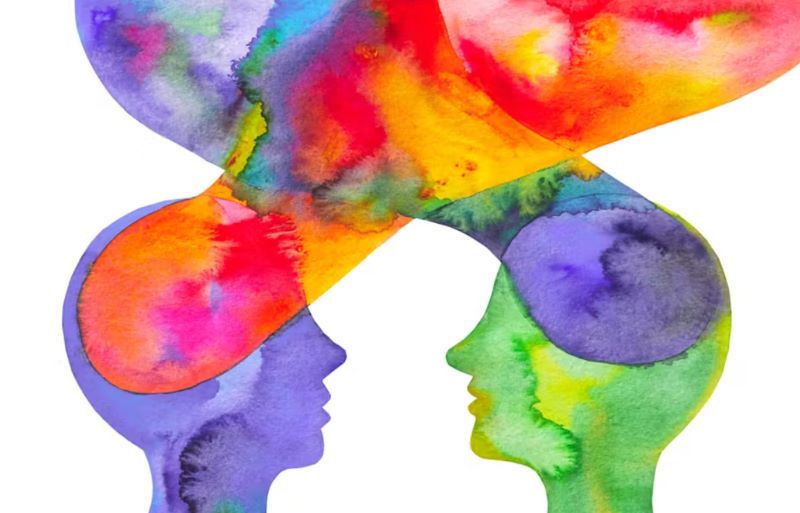
One of the most remarkable human capacities is to perceive and understand mental states.

By Dr. Bertram F. Malle
Professor of Psychology
Brown University
Introduction
One of the most fascinating human capacities is the ability to perceive and interpret other people’s behavior in terms of their mental states. Having an appreciation for the workings of another person’s mind is considered a prerequisite for natural language acquisition (Baldwin & Tomasello, 1998), strategic social interaction (Zhang, Hedden, & Chia, 2012), reflexive thought (Bogdan, 2000), and moral judgment (Guglielmo, Monroe, & Malle, 2009). This capacity develops from early beginnings in the first year of life to the adult’s fast and often effortless understanding of others’ thoughts, feelings, and intentions. And though we must speculate about its evolutionary origin, we do have indications that the capacity evolved sometime in the last few million years.
In this module we will focus on two questions: What is the role of understanding others’ minds in human social life? And what is known about the mental processes that underlie such understanding? For simplicity, we will label this understanding “theory of mind,” even though it is not literally a “theory” that people have about the mind; rather, it is a capacity that some scholars prefer to label “mentalizing” or “mindreading.” But we will go behind all these labels by breaking down the capacity into distinct components: the specific concepts and mental processes that underlie the human understanding of minds.
First, let’s get clear about the roles that this understanding plays in social life.
The Role of Theory of Mind in Social Life

Put yourself in this scene: You observe two people’s movements, one behind a large wooden object, the other reaching behind him and then holding a thin object in front of the other. Without a theory of mind you would neither understand what this movement stream meant nor be able to predict either person’s likely responses. With the capacity to interpret certain physical movements in terms of mental states, perceivers can parse this complex scene into intentional actions of reaching and giving (Baird & Baldwin, 2001); they can interpret the actions as instances of offering and trading; and with an appropriate cultural script, they know that all that was going on was a customer pulling out her credit card with the intention to pay the cashier behind the register. People’s theory of mind thus frames and interprets perceptions of human behavior in a particular way—as perceptions of agents who can act intentionally and who have desires, beliefs, and other mental states that guide their actions (Perner, 1991; Wellman, 1990).
Not only would social perceivers without a theory of mind be utterly lost in a simple payment interaction; without a theory of mind, there would probably be no such things as cashiers, credit cards, and payment (Tomasello, 2003). Plain and simple, humans need to understand minds in order to engage in the kinds of complex interactions that social communities (small and large) require. And it is these complex social interactions that have given rise, in human cultural evolution, to houses, cities, and nations; to books, money, and computers; to education, law, and science.
The list of social interactions that rely deeply on theory of mind is long; here are a few highlights.
- Teaching another person new actions or rules by taking into account what the learner knows or doesn’t know and how one might best make him understand.
- Learning the words of a language by monitoring what other people attend to and are trying to do when they use certain words.
- Figuring out our social standing by trying to guess what others think and feel about us.
- Sharing experiences by telling a friend how much we liked a movie or by showing her something beautiful.
- Collaborating on a task by signaling to one another that we share a goal and understand and trust the other’s intention to pursue this joint goal.
Autism and Theory of Mind

Another way of appreciating the enormous impact that theory of mind has on social interactions is to study what happens when the capacity is severely limited, as in the case of autism (Tager-Flusberg, 2007). In a fascinating discussion in which (high-functioning) autistic individuals talk about their difficulties with other people’s minds (Blackburn, Gottschewski, George, & L—, 2000), one person reports: “I know people’s faces down to the acne scars on the left corners of their chins . . . and how the hairs of their eyebrows curl. . . . The best I can do is start picking up bits of data during my encounter with them because there’s not much else I can do. . . . I’m not sure what kind of information about them I’m attempting to process.” What seems to be missing, as another person with autism remarks, is an “automatic processing of ‘people information.’” Some autistic people report that they perceive others “in a more analytical way.” This analytical mode of processing, however, is very tiresome and slow: “Given time I may be able to analyze someone in various ways, and seem to get good results, but may not pick up on certain aspects of an interaction until I am obsessing over it hours or days later” (Blackburn et al., 2000).
So what is this magical potion that allows most people to gain quick and automatic access to other people’s minds and to recognize the meaning underlying human behavior? Scientific research has accumulated a good deal of knowledge in the past few decades, and here is a synopsis of what we know.
The Mental Processes Underlying Theory of Mind

The first thing to note is that “theory of mind” is not a single thing. What underlies people’s capacity to recognize and understand mental states is a whole host of components—a toolbox, as it were, for many different but related tasks in the social world (Malle, 2008). Figure 1 shows some of the most important tools, organized in a way that reflects the complexity of involved processes: from simple and automatic on the bottom to complex and deliberate on the top. This organization also reflects development—from tools that infants master within the first 6–12 months to tools they need to acquire over the next 3–5 years. Strikingly, the organization also reflects evolution: monkeys have available the tools on the bottom; chimpanzees have available the tools at the second level; but only humans master the remaining tools above. Let’s look at a few of them in more detail.
Agents, Goals, and Intentionality
The agent category allows humans to identify those moving objects in the world that can act on their own. Features that even very young children take to be indicators of being an agent include being self-propelled, having eyes, and reacting systematically to the interaction partner’s behavior, such as following gaze or imitating (Johnson, 2000; Premack, 1990).
The process of recognizing goals builds on this agent category, because agents are characteristically directed toward goal objects, which means they seek out, track, and often physically contact said objects. Even before the end of their first year, infants recognize that humans reach toward an object they strive for even if that object changes location or if the path to the object contains obstacles (Gergely, Nádasdy, Csibra, & Bíró, 1995; Woodward, 1998). What it means to recognize goals, therefore, is to see the systematic and predictable relationship between a particular agent pursuing a particular object across various circumstances.
Through learning to recognize the many ways by which agents pursue goals, humans learn to pick out behaviors that are intentional. The concept of intentionality is more sophisticated than the goal concept. For one thing, human perceivers recognize that some behaviors can be unintentional even if they were goal-directed—such as when you unintentionally make a fool of yourself even though you had the earnest goal of impressing your date. To act intentionally you need, aside from a goal, the right kinds of beliefs about how to achieve the goal. Moreover, the adult concept of intentionality requires that an agent have the skill to perform the intentional action in question: If I am flipping a coin, trying to make it land on heads, and if I get it to land on heads on my first try, you would not judge my action of making it land on heads as intentional—you would say it was luck (Malle & Knobe, 1997).
Imitation, Synchrony, and Empathy

Imitation and empathy are two other basic capacities that aid the understanding of mind from childhood on (Meltzoff & Decety, 2003). Imitation is the human tendency to carefully observe others’ behaviors and do as they do—even if it is the first time the perceiver has seen this behavior. A subtle, automatic form of imitation is called mimicry, and when people mutually mimic one another they can reach a state of synchrony. Have you ever noticed when two people in conversation take on similar gestures, body positions, even tone of voice? They “synchronize” their behaviors by way of (largely) unconscious imitation. Such synchrony can happen even at very low levels, such as negative physiological arousal (Levenson & Ruef, 1992), though the famous claim of synchrony in women’s menstrual cycles is a myth (Yang & Schank, 2006). Interestingly, people who enjoy an interaction synchronize their behaviors more, and increased synchrony (even manipulated in an experiment) makes people enjoy their interaction more (Chartrand & Bargh, 1999). Some research findings suggest that synchronizing is made possible by brain mechanisms that tightly link perceptual information with motor information (when I see you move your arm, my arm-moving program is activated). In monkeys, highly specialized so-called mirror neurons fire both when the monkey sees a certain action and when it performs that same action (Rizzolatti, Fogassi, & Gallese, 2001). In humans, however, things are a bit more complex. In many everyday settings, people perceive uncountable behaviors and fortunately don’t copy all of them (just consider walking in a crowd—hundreds of your mirror neurons would fire in a blaze of confusion). Human imitation and mirroring is selective, triggering primarily actions that are relevant to the perceiver’s current state or aim.
Automatic empathy builds on imitation and synchrony in a clever way. If Bill is sad and expresses this emotion in his face and body, and if Elena watches or interacts with Bill, then she will subtly imitate his dejected behavior and, through well-practiced associations of certain behaviors and emotions, she will feel a little sad as well (Sonnby-Borgström, Jönsson, & Svensson, 2003). Thus, she empathizes with him—whether she wants to or not. Try it yourself. Type “sad human faces” into your Internet search engine and select images from your results. Look at 20 photos and pay careful attention to what happens to your face and to your mood. Do you feel almost a “pull” of some of your facial muscles? Do you feel a tinge of melancholy?
Joint Attention, Visual Perspective Taking
Going beyond the automatic, humans are capable of actively engaging with other people’s mental states, such as when they enter into situations of joint attention—like Marissa and Noah, who are each looking at an object and are both aware that each of them is looking at the object. This sounds more complicated than it really is. Just point to an object when a 3-year old is around and notice how both the child and you check in with each other, ensuring that you are really jointly engaging with the object. Such shared engagement is critical for children to learn the meaning of objects—both their value (is it safe and rewarding to approach?) and the words that refer to them (what do you call this?). When I hold up my keyboard and show it to you, we are jointly attending to it, and if I then say it’s called “Tastatur” in German, you know that I am referring to the keyboard and not to the table on which it had been resting.
Another important capacity of engagement is visual perspective taking: You are sitting at a dinner table and advise another person on where the salt is—do you consider that it is to her left even though it is to your right? When we overcome our egocentric perspective this way, we imaginatively adopt the other person’s spatial viewpoint and determine how the world looks from their perspective. In fact, there is evidence that we mentally “rotate” toward the other’s spatial location, because the farther away the person sits (e.g., 60, 90, or 120 degrees away from you) the longer it takes to adopt the person’s perspective (Michelon & Zacks, 2006).
Projection, Simulation (and the Specter of Egocentrism)
When imagining what it might be like to be in another person’s psychological position, humans have to go beyond mental rotation. One tool to understand the other’s thoughts or feelings is simulation—using one’s own mental states as a model for others’ mental states: “What would it feel like sitting across from the stern interrogator? I would feel scared . . .” An even simpler form of such modeling is the assumption that the other thinks, feels, wants what we do—which has been called the “like-me” assumption (Meltzoff, 2007) or the inclination toward social projection (Krueger, 2007). In a sense, this is an absence of perspective taking, because we assume that the other’s perspective equals our own. This can be an effective strategy if we share with the other person the same environment, background, knowledge, and goals, but it gets us into trouble when this presumed common ground is in reality lacking. Let’s say you know that Brianna doesn’t like Fred’s new curtains, but you hear her exclaim to Fred, “These are beautiful!” Now you have to predict whether Fred can figure out that Brianna was being sarcastic. It turns out that you will have a hard time suppressing your own knowledge in this case and you may overestimate how easy it is for Fred to spot the sarcasm (Keysar, 1994). Similarly, you will overestimate how visible that pimple is on your chin—even though it feels big and ugly to you, in reality very few people will ever notice it (Gilovich & Savitsky, 1999). So the next time when you spot a magnificent bird high up in the tree and you get impatient with your friend who just can’t see what is clearly obvious, remember: it’s obvious to you.
What all these examples show is that people use their own current state—of knowledge, concern, or perception—to grasp other people’s mental states. And though they often do so correctly, they also get things wrong at times. This is why couples counselors, political advisors, and Buddhists agree on at least one thing: we all need to try harder to recognize our egocentrism and actively take other people’s perspective—that is, grasp their actual mental states, even if (or especially when) they are different from our own.
Explicit Mental State Inference

The ability to truly take another person’s perspective requires that we separate what we want, feel, and know from what the other person is likely to want, feel, and know. To do so humans make use of a variety of information. For one thing, they rely on stored knowledge—both general knowledge (“Everybody would be nervous when threatened by a man with a gun”) and agent-specific knowledge (“Joe was fearless because he was trained in martial arts”). For another, they critically rely on perceived facts of the concrete situation—such as what is happening to the agent, the agent’s facial expressions and behaviors, and what the person saw or didn’t see.
This capacity of integrating multiple lines of information into a mental-state inference develops steadily within the first few years of life, and this process has led to a substantial body of research (Wellman, Cross, & Watson, 2001). The research began with a clever experiment by Wimmer and Perner (1983), who tested whether children can pass a false-belief test (see Figure 2). The child is shown a picture story of Sally, who puts her ball in a basket and leaves the room. While Sally is out of the room, Anne comes along and takes the ball from the basket and puts it inside a box. The child is then asked where Sally thinks the ball is located when she comes back to the room. Is she going to look first in the box or in the basket?
The right answer is that she will look in the basket, because that’s where she put it and thinks it is; but we have to infer this false belief against our own better knowledge that the ball is in the box. This is very difficult for children before the age of 4, and it usually takes some cognitive effort in adults (Epley, Morewedge, & Keysar, 2004).
The challenge is clear: People are good at automatically relating to other people, using their own minds as a fitting model for others’ minds. But people need to recognize when to step out of their own perspective and truly represent the other person’s perspective—which may harbor very different thoughts, feelings, and intentions.
Tools in Summary
We have seen that the human understanding of other minds relies on many tools. People process such information as motion, faces, and gestures and categorize it into such concepts as agent, intentional action, or fear. They rely on relatively automatic psychological processes, such as imitation, joint attention, and projection. And they rely on more effortful processes, such as simulation and mental-state inference. These processes all link behavior that humans observe to mental states that humans infer. If we call this stunning capacity a “theory,” it is a theory of mind and behavior.
Folk Explanations of Behavior

Nowhere is this mind–behavior link clearer than in people’s explanations of behavior—when they try to understand why somebody acted or felt a certain way. People have a strong need to answer such “why” questions, from the trivial to the significant: why the neighbor’s teenage daughter is wearing a short skirt in the middle of winter; why the policeman is suddenly so friendly; why the murderer killed three people. The need to explain this last behavior seems puzzling, because typical benefits of explanation are absent: We do not need to predict or control the criminal’s behavior since we will never have anything to do with him. Nonetheless, we have an insatiable desire to understand, to find meaning in this person’s behavior—and in people’s behavior generally.
Older theories of how people explain and understand behavior suggested that people merely identify causes of the behavior (e.g., Kelley, 1967). That is true for most unintentional behaviors—tripping, having a headache, calling someone by the wrong name. But to explain intentional behaviors, people use a more sophisticated framework of interpretation, which follows directly from their concept of intentionality and the associated mental states they infer (Malle, 2004). We have already mentioned the complexity of people’s concept of intentionality; here it is in full (Malle & Knobe, 1997): For an agent to perform a behavior intentionally, she must have a desire for an outcome (what we had called a goal), beliefs about how a particular action leads to the outcome, and an intention to perform that action; if the agent then actually performs the action with awareness and skill, people take it to be an intentional action. To explain why the agent performed the action, humans try to make the inverse inference of what desire and what beliefs the agent had that led her to so act, and these inferred desires and beliefs are the reasons for which she acted. What was her reason for wearing a short skirt in the winter? “She wanted to annoy her mother.” What was the policeman’s reason for suddenly being so nice? “He thought he was speaking with an influential politician.” What was his reason for killing three people? In fact, with such extreme actions, people are often at a loss for an answer. If they do offer an answer, they frequently retreat to “causal history explanations” (Malle, 1999), which step outside the agent’s own reasoning and refer instead to more general background facts—for example, that he was mentally ill or a member of an extremist group. But people clearly prefer to explain others’ actions by referring to their beliefs and desires, the specific reasons for which they acted.
By relying on a theory of mind, explanations of behavior make meaningful what would otherwise be inexplicable motions—just like in our initial example of two persons passing some object between them. We recognize that the customer wanted to pay and that’s why she passed her credit card to the cashier, who in turn knew that he was given a credit card and swiped it. It all seems perfectly clear, almost trivial to us. But that is only because humans have a theory of mind and use it to retrieve the relevant knowledge, simulate the other people’s perspective, infer beliefs and desires, and explain what a given action means. Humans do this effortlessly and often accurately. Moreover, they do it within seconds or less. What’s so special about that? Well, it takes years for a child to develop this capacity, and it took our species a few million years to evolve it. That’s pretty special.
Appendix
Outside Sources
- Blog: On the debate about menstrual synchrony http://blogs.scientificamerican.com/context-and-variation/2011/11/16/menstrual-synchrony/
- Blog: On the debates over mirror neurons http://blogs.scientificamerican.com/guest-blog/2012/11/06/whats-so-special-about-mirror-neurons/
- Book: First and last chapters of Zunshine, L. (2006). Why we read fiction: Theory of mind and the novel. Columbus, OH: Ohio State University Press. https://ohiostatepress.org/Books/Book PDFs/Zunshine Why.pdf
- Movie: A movie that portrays the social difficulties of a person with autism: Adam (Fox Searchlight Pictures, 2009) http://www.imdb.com/title/tt1185836/?ref_=fn_tt_tt_1
- ToM and Autism TEDx Talks https://www.ted.com/playlists/153/the_autism_spectrum
- Video: TED talk on autism http://www.ted.com/talks/temple_grandin_the_world_needs_all_kinds_of_minds.html
- Video: TED talk on empathy http://blog.ted.com/2011/04/18/a-radical-experiment-in-empathy-sam-richards-at-ted-com/
- Video: TED talk on theory of mind and moral judgment http://www.ted.com/talks/rebecca_saxe_how_brains_make_moral_judgments.html
Food for Thought
- Recall a situation in which you tried to infer what a person was thinking or feeling but you just couldn’t figure it out, and recall another situation in which you tried the same but succeeded. Which tools were you able to use in the successful case that you didn’t or couldn’t use in the failed case?
- Mindfulness training improves keen awareness of one’s own mental states. Look up a few such training programs (easily found online) and develop a similar training program to improve awareness of other people’s minds.
- In the near future we will have robots that closely interact with people. Which theory of mind tools should a robot definitely have? Which ones are less important? Why?
- Humans assume that everybody has the capacity to make choices and perform intentional actions. But in a sense, a choice is just a series of brain states, caused by previous brain states and states of the world, all governed by the physical laws of the universe. Is the concept of choice an illusion?
- The capacity to understand others’ minds is intimately related to another unique human capacity: language. How might these two capacities have evolved? Together? One before the other? Which one?
Vocabulary
- Automatic empathy: A social perceiver unwittingly taking on the internal state of another person, usually because of mimicking the person’s expressive behavior and thereby feeling the expressed emotion.
- False-belief test: An experimental procedure that assesses whether a perceiver recognizes that another person has a false belief—a belief that contradicts reality.
- Folk explanations of behavior: People’s natural explanations for why somebody did something, felt something, etc. (differing substantially for unintentional and intentional behaviors).
- Intention: An agent’s mental state of committing to perform an action that the agent believes will bring about a desired outcome.
- Intentionality: The quality of an agent’s performing a behavior intentionally—that is, with skill and awareness and executing an intention (which is in turn based on a desire and relevant beliefs).
- Joint attention: Two people attending to the same object and being aware that they both are attending to it.
- Mimicry: Copying others’ behavior, usually without awareness.
- Mirror neurons: Neurons identified in monkey brains that fire both when the monkey performs a certain action and when it perceives another agent performing that action.
- Projection: A social perceiver’s assumption that the other person wants, knows, or feels the same as the perceiver wants, know, or feels.
- Simulation: The process of representing the other person’s mental state.
- Synchrony: Two people displaying the same behaviors or having the same internal states (typically because of mutual mimicry).
- Theory of mind: The human capacity to understand minds, a capacity that is made up of a collection of concepts (e.g., agent, intentionality) and processes (e.g., goal detection, imitation, empathy, perspective taking).
- Visual perspective taking: Can refer to visual perspective taking (perceiving something from another person’s spatial vantage point) or more generally to effortful mental state inference (trying to infer the other person’s thoughts, desires, emotions).
References
- Baird, J. A., & Baldwin, D. A. (2001). Making sense of human behavior: Action parsing and intentional inference. In B. F. Malle, L. J. Moses, & D. A. Baldwin (Eds.), Intentions and intentionality: Foundations of social cognition (pp. 193–206). Cambridge, MA:MIT Press.
- Baldwin, D. A., & Tomasello, M. (1998). Word learning: A window on early pragmatic understanding. In E. V. Clark (Ed.), The proceedings of the twenty-ninth annual child language research forum (pp. 3–23). Chicago, IL: Center for the Study of Language and Information.
- Blackburn, J., Gottschewski, K., George, E., & L—, N. (2000, May). A discussion about theory of mind: From an autistic perspective. Proceedings of Autism Europe’s 6th International Congress. Glasgow. Retrieved from http://archive.autistics.org/library/AE2000-ToM.html.
- Bogdan, R. (2000). Minding minds: Evolving a reflexing mind by interpreting others. Cambridge, MA: MIT Press.
- Chartrand, T. L., & Bargh, J. A. (1999). The chameleon effect: The perception–behavior link and social interaction. Journal of Personality and Social Psychology, 76, 893–910.
- Epley, N., Morewedge, C. K., & Keysar, B. (2004). Perspective taking in children and adults: Equivalent egocentrism but differential correction. Journal of Experimental Social Psychology, 40, 760–768.
- Gergely, G., Nádasdy, Z., Csibra, G., & Bíró, S. (1995). Taking the intentional stance at 12 months of age. Cognition, 56, 165–193.
- Gilovich, T., & Savitsky, K. (1999). The spotlight effect and the illusion of transparency: Egocentric assessments of how we are seen by others. Current Directions in Psychological Science, 8, 165–168.
- Guglielmo, S., Monroe, A. E., & Malle, B. F. (2009). At the heart of morality lies folk psychology. Inquiry: An Interdisciplinary Journal of Philosophy, 52, 449–466.
- Johnson, S. C. (2000). The recognition of mentalistic agents in infancy. Trends in Cognitive Sciences, 4, 22–28.
- Kelley, H. H. (1967). Attribution theory in social psychology. In D. Levine (Ed.), Nebraska Symposium on Motivation (Vol. 15, pp. 192–240). Lincoln: University of Nebraska Press.
- Keysar, B. (1994). The illusory transparency of intention: Linguistic perspective taking in text. Cognitive Psychology, 26, 165–208.
- Krueger, J. I. (2007). From social projection to social behaviour. European Review of Social Psychology, 18, 1–35.
- Levenson, R. W., & Ruef, A. M. (1992). Empathy: A physiological substrate. Journal of Personality and Social Psychology, 63, 234–246.
- Malle, B. F. (2008). The fundamental tools, and possibly universals, of social cognition. In R. M. Sorrentino & S. Yamaguchi (Eds.), Handbook of motivation and cognition across cultures (pp. 267–296). New York, NY: Elsevier/Academic Press.
- Malle, B. F. (2004). How the mind explains behavior: Folk explanations, meaning, and social interaction. Cambridge, MA: MIT Press.
- Malle, B. F. (1999). How people explain behavior: A new theoretical framework. Personality and Social Psychology Review, 3, 23–48.
- Malle, B. F., & Knobe, J. (1997). The folk concept of intentionality. Journal of Experimental Social Psychology, 33, 101–121.
- Meltzoff, A. N. (2007). “Like me”: A foundation for social cognition. Developmental Science, 10, 126–134.
- Meltzoff, A. N., & Decety, J. (2003). What imitation tells us about social cognition: A rapprochement between developmental psychology and cognitive neuroscience. Philosophical Transactions of the Royal Society of London. Series B: Biological Sciences, 358, 491–500.
- Michelon, P., & Zacks, J. M. (2006). Two kinds of visual perspective taking. Perception & Psychophysics, 68, 327–337.
- Perner, J. (1991). Understanding the representational mind. Cambridge, MA: MIT Press.
- Premack, D. (1990). The infant’s theory of self-propelled objects. Cognition, 36, 1–16.
- Rizzolatti, G., Fogassi, L., & Gallese, V. (2001). Neurophysiological mechanisms underlying the understanding and imitation of action. Nature Reviews Neuroscience, 2, 661–670.
- Sonnby-Borgström, M., Jönsson, P., & Svensson, O. (2003). Emotional empathy as related to mimicry reactions at different levels of information processing. Journal of Nonverbal Behavior, 27, 3–23.
- Tager-Flusberg, H. (2007). Evaluating the theory-of-mind hypothesis of autism. Current Directions in Psychological Science, 16, 311–315.
- Tomasello, M. (2003). The key is social cognition. In D. Gentner & S. Goldin-Meadow (Eds.), Language in mind: Advances in the study of language and thought (pp. 47–57). Cambridge, MA: MIT Press.
- Wellman, H. M. (1990). The child’s theory of mind. Cambridge, MA: MIT Press.
- Wellman, H. M., Cross, D., & Watson, J. (2001). Meta-analysis of theory-of-mind development: The truth about false belief. Child Development, 72, 655–684.
- Wimmer, H., & Perner, J. (1983). Beliefs about beliefs: Representation and constraining function of wrong beliefs in young children’s understanding of deception. Cognition, 13, 103–128.
- Woodward, A. L. (1998). Infants selectively encode the goal object of an actor’s reach. Cognition, 69, 1–34.
- Yang, Z., & Schank, J. C. (2006). Women do not synchronize their menstrual cycles. Human Nature, 17, 433–447.
- Zhang, J., Hedden, T., & Chia, A. (2012). Perspective-taking and depth of theory-of-mind reasoning in sequential-move games. Cognitive Science, 36, 560–573.
Originally published by NOBA (Diener Education Fund) under the terms of a Creative Commons Attribution-NonCommercial-ShareAlike 4.0 International license.





